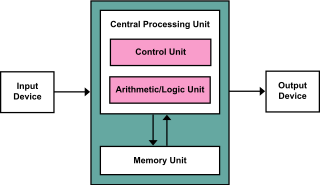
Middlesex University London is a public research university in Hendon, northwest London, England. The name of the university is taken from its location within the historic county boundaries of Middlesex.
Computer art is any art in which computers play a role in production or display of the artwork. Such art can be an image, sound, animation, video, CD-ROM, DVD-ROM, video game, website, algorithm, performance or gallery installation. Many traditional disciplines are now integrating digital technologies and, as a result, the lines between traditional works of art and new media works created using computers has been blurred. For instance, an artist may combine traditional painting with algorithm art and other digital techniques. As a result, defining computer art by its end product can thus be difficult. Computer art is bound to change over time since changes in technology and software directly affect what is possible.

Electronic art is a form of art that makes use of electronic media. More broadly, it refers to technology and/or electronic media. It is related to information art, new media art, video art, digital art, interactive art, internet art, and electronic music. It is considered an outgrowth of conceptual art and systems art.

The von Neumann architecture—also known as the von Neumann model or Princeton architecture—is a computer architecture based on a 1945 description by John von Neumann and others in the First Draft of a Report on the EDVAC. That document describes a design architecture for an electronic digital computer with these components:

Chelsea College of Arts is a constituent college of the University of the Arts London based in London, UK, and is a leading British art and design institution with an international reputation. It offers further and higher education courses in fine art, graphic design, interior design, spatial design and textile design up to PhD level.

London Guildhall University was a university in the United Kingdom from 1992 to 2002, established when the City of London Polytechnic was awarded university status. On 1 August 2002, it merged with the University of North London to form London Metropolitan University. The former London Guildhall University premises now form the new University's City campus, situated on various sites in the City of London.

The UCL Slade School of Fine Art is the art school of University College London (UCL) and is based in London, England. The school is organised as a department of UCL's Faculty of Arts and Humanities.
Keith Waters is a British animator who is best known for his work in the field of computer facial animation. He has received international awards from Parigraph, the National Computer Graphics Association and the Computer Animation Film Festival.
The Slade Centre for Electronic Media in Fine Art (SCEMFA) opened in 1995 at the Slade School of Fine Art, University College London. The centre provides opportunities for research into electronic media and fine art with the goal of contributing to debate on national and international levels.

Robert John Lansdown was a British computer graphics pioneer, polymath and Professor Emeritus at Middlesex University Lansdown Centre for Electronic Arts, which was renamed in his honour in 2000.

Brian Reffin Smith is an artist, writer, teacher and musician born in Sudbury, Suffolk, in the United Kingdom, who won the first-ever Prix Ars Electronica, the Golden Nica, in Linz, Austria, 1987. He lives in Berlin, Germany.
The Computer Arts Society (CAS) was founded in 1968, in order to encourage the creative use of computers in the arts.
System Simulation (SSL) is a software engineering company now specialising in text and multimedia information systems, based in Covent Garden, central London, England, and founded in 1970.
Charlie Gere is a British academic who is professor of media theory and history at The Lancaster Institute for the Contemporary Arts, The University of Lancaster and previously, director of research at the Institute for Cultural Research at The University of Lancaster. He is author of several books and articles on new media art, art and technology, continental philosophy and technology. His main research interest is in the cultural effects and meanings of technology and media, particularly in relation to post-conceptual art and philosophy.

Jimmy Hotz is an American inventor, record producer, recording engineer, electronic music pioneer, audio expert, author and musician.

Doron Swade MBE is a museum curator and author, specialising in the history of computing. He is especially known for his work on the computer pioneer Charles Babbage and his Difference Engine.

New media art refers to artworks created with new media technologies, including digital art, computer graphics, computer animation, virtual art, Internet art, interactive art, sound art, video games, computer robotics, 3D printing, cyborg art and art as biotechnology. The term differentiates itself by its resulting cultural objects and social events, which can be seen in opposition to those deriving from old visual arts. This concern with medium is a key feature of much contemporary art and many art schools and major universities now offer majors in "New Genres" or "New Media" and a growing number of graduate programs have emerged internationally. New media art often involves interaction between artist and observer or between observers and the artwork, which responds to them. Yet, as several theorists and curators have noted, such forms of interaction, social exchange, participation, and transformation do not distinguish new media art but rather serve as a common ground that has parallels in other strands of contemporary art practice. Such insights emphasize the forms of cultural practice that arise concurrently with emerging technological platforms, and question the focus on technological media, per se.

Catherine Mason is an art historian and author who specialises in digital art, especially computer art.

Event One was an early digital art exhibition held at the Royal College of Art (RCA), London, England, in 1969.
White Heat Cold Logic (2008), edited by Paul Brown, Charlie Gere, Nicholas Lambert, and Catherine Mason, is a book about the history of British computer art during 1960–1980.













